|
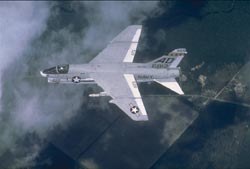 The A-7A flew its first combat mission in Vietnam on 4 December 1967, only two years and three months after first flight! By the time the war ended on 28 January 1973, the A-7A's had been joined by the A-7B, A-7C, A-7D and A-7E. Navy A-7's were flown by 20 different squadrons from 10 different aircraft carriers involving 52 combat deployments by the U. S. Navy. The Navy flew 49,200 combat sorties in A-7A's and A-7C's, accruing 208,795 combat flight hours for an average of 2.25 hours per sortie. A total of 186,000 tons of ordnance was delivered against the enemy, with only 54 A-7's lost to enemy fire. This equates to an overall loss rate of only 0.00059 per sortie, or one loss for every 1670 sorties. In terms of ordnance delivered, that is a rate of 3444 tons on enemy targets for each airplane lost in combat. The A-7A flew its first combat mission in Vietnam on 4 December 1967, only two years and three months after first flight! By the time the war ended on 28 January 1973, the A-7A's had been joined by the A-7B, A-7C, A-7D and A-7E. Navy A-7's were flown by 20 different squadrons from 10 different aircraft carriers involving 52 combat deployments by the U. S. Navy. The Navy flew 49,200 combat sorties in A-7A's and A-7C's, accruing 208,795 combat flight hours for an average of 2.25 hours per sortie. A total of 186,000 tons of ordnance was delivered against the enemy, with only 54 A-7's lost to enemy fire. This equates to an overall loss rate of only 0.00059 per sortie, or one loss for every 1670 sorties. In terms of ordnance delivered, that is a rate of 3444 tons on enemy targets for each airplane lost in combat. 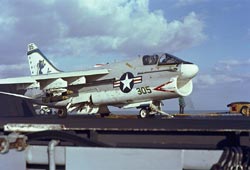 The newer A-7E's, with their one-pass bombing accuracy made possible by improved avionics, computer-driven systems, and the new engines, achieved a loss rate reduction of almost 25% over that of the earlier A-7's. This is an astounding record when it is considered that these airplanes provided the most accurate weapon delivery system in the war. The newer A-7E's, with their one-pass bombing accuracy made possible by improved avionics, computer-driven systems, and the new engines, achieved a loss rate reduction of almost 25% over that of the earlier A-7's. This is an astounding record when it is considered that these airplanes provided the most accurate weapon delivery system in the war.
.The first U. S. Air Force A-7D's were deployed from Myrtle Beach Air Force Base, South Carolina, to Korat Royal Thai AFB in mid-October 1972. For the next 10 weeks, the 354th Tactical Fighter Wing's 72 aircraft averaged 62 missions per day, producing a total of 6568 sorties in 16,819 combat flying hours. 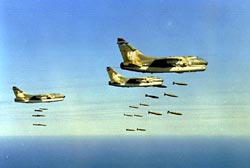 Their radius of action averaged 350 miles and extended as far out as 550 miles. The Deputy Commander for Operations of the 354th TFW, upon arrival in Thailand, commented that, "This is one of the few times in history that a Wing of fighter aircraft has departed from the United States and arrived at an overseas destination with all aircraft, and arrived on schedule." Their radius of action averaged 350 miles and extended as far out as 550 miles. The Deputy Commander for Operations of the 354th TFW, upon arrival in Thailand, commented that, "This is one of the few times in history that a Wing of fighter aircraft has departed from the United States and arrived at an overseas destination with all aircraft, and arrived on schedule."
Included in their combat tours, A-7D wings flew 5796 strike missions, 542 search and rescue missions, and 230 Linebacker II missions. Units that served included:
- 3d Tactical Fighter Squadron - SAR, Korat RTAFB, Thailand
- 65th Tactical Fighter Squadron, Nellis AFB, Nevada
- 354th Tactical Fighter Wing, Myrtle Beach AFB, South Carolina
- 355th Tactical Fighter Wing, Davis-Monthan AFB, Arizona
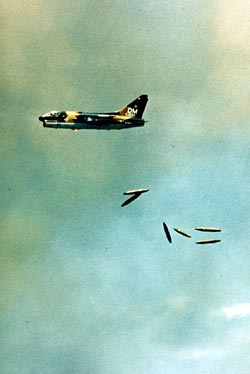 The A-7 did, indeed, distinguish itself in combat and was a favorite of the ground troops when they needed air cover. The reason was simple; the A-7 was the only combat aircraft that could be depended upon to put ordnance safely on targets close to the troops. Many are alive today because of the A-7's superior weapons delivery capability in such combat situations and its long loiter time in rescue missions. The A-7 was the only combat airplane that had long flight duration capabilities and could fly as slow or as fast as needed for the situation. It could not be matched then for these attributes, nor can it be matched today. When one veteran pilot was asked what could be done to make the A-7 better he replied, "About the only improvement I can think of is to make it a little prettier.” The A-7 did, indeed, distinguish itself in combat and was a favorite of the ground troops when they needed air cover. The reason was simple; the A-7 was the only combat aircraft that could be depended upon to put ordnance safely on targets close to the troops. Many are alive today because of the A-7's superior weapons delivery capability in such combat situations and its long loiter time in rescue missions. The A-7 was the only combat airplane that had long flight duration capabilities and could fly as slow or as fast as needed for the situation. It could not be matched then for these attributes, nor can it be matched today. When one veteran pilot was asked what could be done to make the A-7 better he replied, "About the only improvement I can think of is to make it a little prettier.”
The end of hostilities in Southeast Asia did not end the combat life of the Corsair II. There was still more for the A-7 to accomplish in the coming years, as noted below.
- A-7E squadrons VA-15 and VA-87, from the USS Independence, provided close air support over Granada in October 1983. Vice Admiral Metcalf, Commander of the 2d Fleet was quoted as saying,
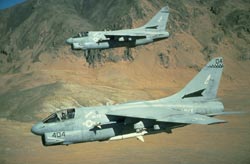 "The A-7 provided the turning point in the battle of St. George, allowing the multinational force (Jamaica, Barbados, Venezuela, and the United States) to quickly gain he upper hand." "The A-7 provided the turning point in the battle of St. George, allowing the multinational force (Jamaica, Barbados, Venezuela, and the United States) to quickly gain he upper hand."
- In response to terrorist activities in 1986, A-7E's from the USS America were part of a task force that attacked suspected terrorist training camps in Libya on 15 April of that year. The six A-7E's that participated provided support in suppression of surface-to-air weapons.
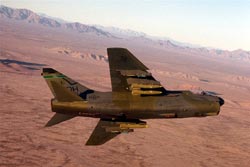 The 180th Tactical Fighter Group Ohio National Guard unit was in Panama when hostilities began in late December and participated in the invasion. They were among the ANG units that rotated there to provide a presence in Panama in an exercise called "Coronet Cove." The 180th Tactical Fighter Group Ohio National Guard unit was in Panama when hostilities began in late December and participated in the invasion. They were among the ANG units that rotated there to provide a presence in Panama in an exercise called "Coronet Cove."
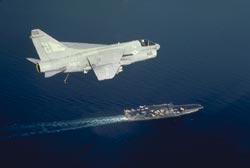 The last A-7E squadrons in Navy service, VA-46 and VA-72, provided support for Desert Storm from the USS Kennedy. Desert Storm operations produced 725 sorties, that averaged 4.3 hours each, for a total of 3100 combat flight hours. In these operations A-7's carried a variety of ordnance and also served as tankers during the action. No A-7's were lost to enemy action during the entire operation. The two squadrons returned to Cecil Field, Florida, and were decommissioned on 23 May 1991. The last A-7E squadrons in Navy service, VA-46 and VA-72, provided support for Desert Storm from the USS Kennedy. Desert Storm operations produced 725 sorties, that averaged 4.3 hours each, for a total of 3100 combat flight hours. In these operations A-7's carried a variety of ordnance and also served as tankers during the action. No A-7's were lost to enemy action during the entire operation. The two squadrons returned to Cecil Field, Florida, and were decommissioned on 23 May 1991.
A-7:
Genesis of the Navy Attack Bomber, Light (VA(L))
The A-7 in Combat
A-7 Aircraft Performance Perspective
Low Altitude Night Attack (LANA)
Farewell Proud Bird
|

 The A-7A flew its first combat mission in Vietnam on 4 December 1967, only two years and three months after first flight! By the time the war ended on 28 January 1973, the A-7A's had been joined by the A-7B, A-7C, A-7D and A-7E. Navy A-7's were flown by 20 different squadrons from 10 different aircraft carriers involving 52 combat deployments by the U. S. Navy. The Navy flew 49,200 combat sorties in A-7A's and A-7C's, accruing 208,795 combat flight hours for an average of 2.25 hours per sortie. A total of 186,000 tons of ordnance was delivered against the enemy, with only 54 A-7's lost to enemy fire. This equates to an overall loss rate of only 0.00059 per sortie, or one loss for every 1670 sorties. In terms of ordnance delivered, that is a rate of 3444 tons on enemy targets for each airplane lost in combat.
The A-7A flew its first combat mission in Vietnam on 4 December 1967, only two years and three months after first flight! By the time the war ended on 28 January 1973, the A-7A's had been joined by the A-7B, A-7C, A-7D and A-7E. Navy A-7's were flown by 20 different squadrons from 10 different aircraft carriers involving 52 combat deployments by the U. S. Navy. The Navy flew 49,200 combat sorties in A-7A's and A-7C's, accruing 208,795 combat flight hours for an average of 2.25 hours per sortie. A total of 186,000 tons of ordnance was delivered against the enemy, with only 54 A-7's lost to enemy fire. This equates to an overall loss rate of only 0.00059 per sortie, or one loss for every 1670 sorties. In terms of ordnance delivered, that is a rate of 3444 tons on enemy targets for each airplane lost in combat.  The newer A-7E's, with their one-pass bombing accuracy made possible by improved avionics, computer-driven systems, and the new engines, achieved a loss rate reduction of almost 25% over that of the earlier A-7's. This is an astounding record when it is considered that these airplanes provided the most accurate weapon delivery system in the war.
The newer A-7E's, with their one-pass bombing accuracy made possible by improved avionics, computer-driven systems, and the new engines, achieved a loss rate reduction of almost 25% over that of the earlier A-7's. This is an astounding record when it is considered that these airplanes provided the most accurate weapon delivery system in the war.
 Their radius of action averaged 350 miles and extended as far out as 550 miles. The Deputy Commander for Operations of the 354th TFW, upon arrival in Thailand, commented that, "This is one of the few times in history that a Wing of fighter aircraft has departed from the United States and arrived at an overseas destination with all aircraft, and arrived on schedule."
Their radius of action averaged 350 miles and extended as far out as 550 miles. The Deputy Commander for Operations of the 354th TFW, upon arrival in Thailand, commented that, "This is one of the few times in history that a Wing of fighter aircraft has departed from the United States and arrived at an overseas destination with all aircraft, and arrived on schedule."
 The A-7 did, indeed, distinguish itself in combat and was a favorite of the ground troops when they needed air cover. The reason was simple; the A-7 was the only combat aircraft that could be depended upon to put ordnance safely on targets close to the troops. Many are alive today because of the A-7's superior weapons delivery capability in such combat situations and its long loiter time in rescue missions. The A-7 was the only combat airplane that had long flight duration capabilities and could fly as slow or as fast as needed for the situation. It could not be matched then for these attributes, nor can it be matched today. When one veteran pilot was asked what could be done to make the A-7 better he replied, "About the only improvement I can think of is to make it a little prettier.”
The A-7 did, indeed, distinguish itself in combat and was a favorite of the ground troops when they needed air cover. The reason was simple; the A-7 was the only combat aircraft that could be depended upon to put ordnance safely on targets close to the troops. Many are alive today because of the A-7's superior weapons delivery capability in such combat situations and its long loiter time in rescue missions. The A-7 was the only combat airplane that had long flight duration capabilities and could fly as slow or as fast as needed for the situation. It could not be matched then for these attributes, nor can it be matched today. When one veteran pilot was asked what could be done to make the A-7 better he replied, "About the only improvement I can think of is to make it a little prettier.”
 "The A-7 provided the turning point in the battle of St. George, allowing the multinational force (Jamaica, Barbados, Venezuela, and the United States) to quickly gain he upper hand."
"The A-7 provided the turning point in the battle of St. George, allowing the multinational force (Jamaica, Barbados, Venezuela, and the United States) to quickly gain he upper hand." The 180th Tactical Fighter Group Ohio National Guard unit was in Panama when hostilities began in late December and participated in the invasion. They were among the ANG units that rotated there to provide a presence in Panama in an exercise called "Coronet Cove."
The 180th Tactical Fighter Group Ohio National Guard unit was in Panama when hostilities began in late December and participated in the invasion. They were among the ANG units that rotated there to provide a presence in Panama in an exercise called "Coronet Cove." The last A-7E squadrons in Navy service, VA-46 and VA-72, provided support for Desert Storm from the USS Kennedy. Desert Storm operations produced 725 sorties, that averaged 4.3 hours each, for a total of 3100 combat flight hours. In these operations A-7's carried a variety of ordnance and also served as tankers during the action. No A-7's were lost to enemy action during the entire operation. The two squadrons returned to Cecil Field, Florida, and were decommissioned on 23 May 1991.
The last A-7E squadrons in Navy service, VA-46 and VA-72, provided support for Desert Storm from the USS Kennedy. Desert Storm operations produced 725 sorties, that averaged 4.3 hours each, for a total of 3100 combat flight hours. In these operations A-7's carried a variety of ordnance and also served as tankers during the action. No A-7's were lost to enemy action during the entire operation. The two squadrons returned to Cecil Field, Florida, and were decommissioned on 23 May 1991.